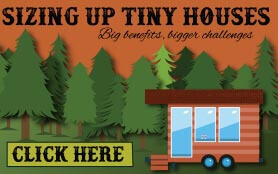Comparing the benefits versus the challenges of going tiny.
The tiny house movement is a trend in real estate where owners opt to dramatically downsize their homes and lifestyle to simplify and significantly reduce costs. However, the cost of going small is much bigger than you might think.


Focus on financing – is tiny any better?
Lifestyle choices aside, the real question we wanted to answer was whether transitioning to a tiny house is better for your bottom line. Unfortunately the answer is that while tiny housing is better for your budget long-term, the initial investment can be tough to meet. In some cases, it’s even harder than transitioning to a traditional sized home because the mortgage industry doesn’t like to go small.
In many cases, one of the biggest challenges that families face when they buy a home – any home – is the cost of the down payment. Generating the $40,000 you’d need for a down payment on a $200,000 home if you want to secure a 30-year fixed rate mortgage without having to worry about mortgage insurance. Even generating a $6,000 for the 3% down payment required for an FHA loan can be tough for families given all of their other financial obligations.
So how is generating $23,000 for the cost of a tiny house PLUS the cost of the land you purchase if you have to purchase land to put it on, any better? The simple answer is that it’s not.
Big interest charges on tiny house credit purchases
One commonly used solution to financing a tiny house is to put the total housing costs on a high interest credit card. However, this can be a risky situation to get into with revolving debt. The borrower would have to plan carefully to avoid paying exorbitant interest charges, because while the average interest rate on a mortgage is usually less than 5%, the average rate on a credit card is closer to 15%.
If you put $23,000 on a credit card at 15% APR and made only minimum payments, it would take 346 payments (almost 29 years) to pay off the debt in full. Over that period of time, you’d pay $22,636.97 in interest charges. So you practically double the cost of your tiny home because it ends up costing $45,636.97.
If you choose to put this kind of major purchase on a credit card, then you MUST have a solid strategy for paying the debt off. Keep in mind that you won’t have any housing costs and your utilities would already be reduced, so you have to make a plan to pay off the debt as quickly as possible.
So, for instance, if you can commit to paying $1,500 which is comparable to mortgage and rent payments you’d be making, you can pay off the debt in-full within 18 months. In this case, interest charges would only total $2,693.99, so your total cost with interest charges factored in would only be $25,693.99. However, again keep in mind that this doesn’t include the cost of the land where you put your tiny house.
Finding the right help is key… and kind of difficult
In doing research for this project, our staff writer reached out to several Realtors® in South Florida and found that finding assistance in transitioning to a tiny house may also be harder than you expected. You can’t just reach out to a regular agent or someone you just find through normal channels like recommendations or real estate websites. Most traditional real estate agents simply aren’t versed in tiny houses and the property laws associated with them.
For instance, our writer wanted to find out about minimum square footage requirements in Broward County, but none of the three Realtors® could find that information. They also couldn’t refer us to a mortgage broker who would finance a mortgage for less than $50,000. And in most cases when asked to go small, they insisted that efficiency apartments were the only way to go.
So if you want to find or construct a tiny home, you need a real estate agent, a home builder, AND a real estate attorney that are all versed in tiny homes. Even if you plan to construct the property, you will still need someone to help you find land and navigate the building process so you don’t get popped with code violation fines because your tiny house isn’t up to code.